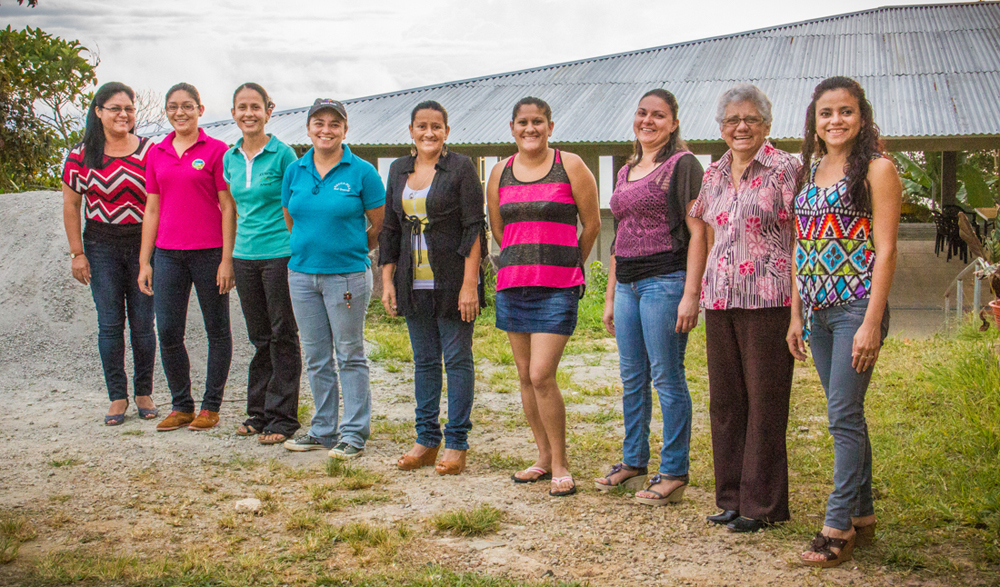Lesley Chilcott and her husband own a farm in Costa Rica, not all that far from the headquarters of ASOMOBI, a sustainable coffee roasting collective run entirely by women that has had great success in not only lifting the quality of life in the region but has inspired like-minded operations across the globe in such places as Rwanda and Tanzania. Yet when Chilcott was approached to make a film about them, tipped off in part by the Italian java distributor Illy, who had been buying beans from the women for years, she had no idea how to find them.
“You ask your average Costa Rican where [they’re located] and nobody knows. It’s that remote,” says Chilcott, who previously produced such films as “An Inconvenient Truth” and “Waiting for Superman.” “Unless you say it’s in the Talamanca Mountains, people don’t know the area, which makes it all the more amazing what these women were able to pull off.”
Yet that anonymity may not last much longer with the release of “A Small Section of the World,” which shines a spotlight on both an overlooked region and the overlooked role of women in the coffee industry who represent a disproportionate amount of the labor while rarely having ownership of the crops. It’s an auspicious feature debut for Chilcott, who traces how ASOMOBI ties into a global network of female coffee growers increasingly taking control of their own destiny. The film captures a critical moment in the history of ASOMOBI as it chronicles a generational shift from the founders, who grew their business from nothing as a means of pursuing financial independence from their husbands who searched for work elsewhere, to a new era that has inherited their strong work ethic in the fields but also cultivated an equally savvy business sense.
Following recent screenings at DOC NYC and the State Department, the film arrives in Los Angeles this week before debuting on VOD and to celebrate the occasion, Chilcott spoke about moving to the director’s chair for “A Small Section of the World,” overcoming her preference for tea and finding the film’s themes in the edit.

We’re always transitioning, right? [laughs] During “Waiting for Superman,” there were so many shooting days that Davis [Guggenheim], the director, and I had to split up, so I had to fill in for him on occasion and I would do things the way I thought he would want them done and how he would direct them. Unfortunately, I caught the bug and I was really happy as a producer on documentaries for so many years, I had been lucky enough to work with people like Davis where I still had some creative involvement, but with things going more digital and happening more quickly now, I just thought I would have more control over the types of things that I worked on if I took that helm. So I started doing it with shorts and those led to this and I have another project slated to start in January, so hopefully it will continue. I still intend to produce. It’s hard for me to give that up and if the right project came along, I would produce for another director as well.
The film begins with ASOMOBI and gradually expands to show the global network of female coffee roasters. Did the way the film is structured reflect how you learned of this yourself or did you know of the global network first?
It’s more the latter. I will tell you something – I do not drink coffee, so because of this, I’ve always been fascinated by how particular people are about their coffee — “Oh no, it needs to have raw sugar. It has to be prepared this way,” all these things. So because I had this shortfall of not drinking coffee, I felt I had to make up for it by educating myself and I started reading books on the history of coffee. I became fascinated with how it’s so interwoven amongst wars and our history and in that process, I started learning about the Women’s International Coffee Alliance.
We joked around in the editing room how we were showing how ASOMOBI as part of a quiet revolution of women. 70% of the workers worldwide in coffee are women, yet only 10 or 15% of them own the land or are in charge, and there’s 125 million people involved in coffee worldwide, so we’re talking about a very large group of women. When they do things like the ASOMOBI women did, and they learn how to negotiate [the price of beans] and learn how important the soil and the growing and the milling and the roasting and all of that is, they’re able to get a higher price for their coffee, which directly changes their family and their communities.
You meet a young woman named Samanta, who would seem to represent the future as someone who is business savvy, but also obviously from the tradition of her forebears with her agricultural knowhow. How did she become a focus?
Last November, I was actually shooting in Connecticut and I thought, “Hang on a second, isn’t coffee season ending?” And we ended up going on this very quick trip, flying directly from New York to Costa Rica, so we could get there for the final days of the harvest. So all the footage of the coffee picking and the fields [that’s in the film] is from this trip last November, but we had asked Grace Mena, the exporter in the film, to come down and meet us, and Samanta happened to be visiting that weekend from college. She was the only one kind of buzzing around with her laptop. Everywhere I went, she was there, and I’m like, “What are you doing?” And she said, “I graduate in a year and I’m writing my thesis on ASOMOBI,” so I started asking her more and more questions. You see what a fireball Grace is in the film, so I knew she had to be a leading character, but I still was making a film about where does coffee come from and how to leave something for the next generation. It wasn’t until later that I began to tie all the different stories together and make it more a women’s empowerment as a whole film. That happened in the edit.
Your next film is actually about young women in the tech world. Is it a coincidence that your first two films will share a theme of empowerment in common or do you feel these are stories that you need to tell?
I think both. It’s a coincidence because I wanted to make the girls in tech film a couple years ago, but I did this project instead. The contest [I’m following] starts every year in January and it’s called Technovation. Girls from all over the world compete and within a period of 12 weeks, they’re supposed to create an app that solves a problem in their local community. These girls at 15, 16 and 17 are just completely transformed by creating these apps. First, they didn’t know they could computer program. Second, they didn’t know they could come up with these cool projects and third, teenage girls don’t have a lot of control over what goes on in their life and this is a way that shows them hey, if I don’t like something, I can fix it. It seemed like such great material, so while it’s a bit of a coincidence, I’m on a roll, so why not?
You were actually able to screen this film recently at the State Department. What was that screening like?
That was really an honor. It was very well-attended and there were some extremely intelligent questions asked from the audience afterwards. Grace Mena flew to DC and it was great because it was a lot of State Department staffers and members of the diplomatic core were there, as well as some college kids and others working on fellowships, so it was a lot of fun and a real honor to be able to share it with them.
In the types of films you’ve worked on, it seems like the outreach has become as much a part of the process and the making of the film and I notice you like to engage in a lot of panel discussions around your screenings rather than straight Q & As. How important is that for the kinds of goals you have for the films you make?
That’s a very good question because in my estimation, “A Small Section of the World” is not a political film. It’s a story about what these wonderful women overcame and what they achieved. It’s really thinking about is where your food comes from and all the work that goes into it and in this case, how many women helped make that particular cup of coffee. So I kept insisting it wasn’t a political film, but when we were invited to screen at the State Department, I realized it did have a larger context, even though I hadn’t intended that.
However, whenever you make a documentary, you say, “Okay, the documentary is about A, B and C and here’s my treatment.” It almost never turns out like what you intended because if you’re being true to the story and you meet somebody like Samanta, your story takes a left turn and it turns into something else. So to get to your actual question, I’m starting to question how efficient are these panels? But then when I’m actually there with that group of 50 or at the State Department, with 200 people, when you get that interaction and you see that people are inspired by a particular piece that you’ve done, it does seem like it’s a good thing to do because locally in each area that you go, you’re helping to create this new conversation and getting people to think about things.
“A Small Section of the World” will screen on December 4th at the Arclight Hollywood with a panel discussion to follow. It also opens on December 19th at the Quad Cinema in New York and will become available on Amazon Instant Video, Comcast’s Xfinity TV, Google Play, iTunes, Sony PlayStation, Time Warner Cable, Vudu and Xbox Video on December 16th.




